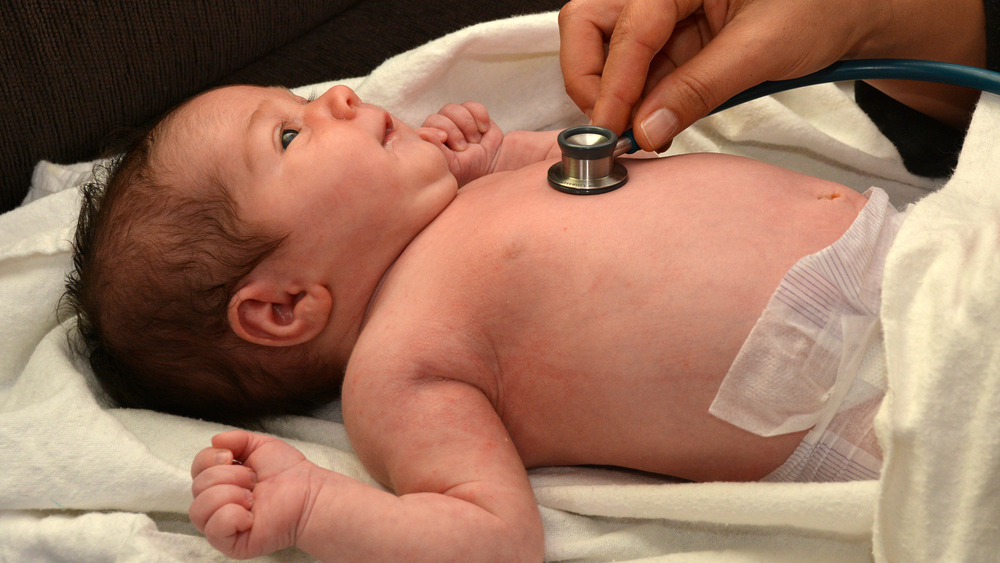How to Treat Torticollis in Babies, Causes, and Symptoms
Is your baby displaying signs of discomfort or restricted movement in their neck? Do you understand how to treat torticollis in babies? Are you confused about where to start?
Torticollis in infants, a condition that affects the muscles in the neck, can be a cause of concern for parents. Understanding the causes, diagnosis, and treatment options for torticollis is crucial for promoting your baby’s well-being and development.
Torticollis in babies may manifest as a tilted or twisted neck, limiting their range of motion. It can be congenital or acquired, and various underlying factors contribute to its development.
Early detection through physical exams is key. Treatment options such as gentle muscle stretches, positioning changes, and physical therapy can help manage torticollis effectively and prevent long-term complications.
This blog explores how to treat torticollis in babies, its symptoms, causes, and practical strategies recommended by healthcare providers to help parents navigate the challenges of infant torticollis while nurturing their child’s healthy growth and development.
Torticollis in Babies

Torticollis is a condition characterized by the abnormal positioning or tilting of a baby’s neck. It can be concerning for parents, but it can be effectively managed with proper treatment and care. Torticollis can occur in infants due to various factors, including tight or shortened neck muscles, positioning in the womb, or birth trauma.
The most common type of torticollis in babies is congenital muscular torticollis (CMT), which is usually identified in the first few months of life. Babies with torticollis may display symptoms such as head tilting to one side, limited neck movement, and muscle stiffness.
It’s important to address torticollis promptly, as it can impact a baby’s development. The condition may affect the baby’s ability to explore the environment, maintain proper posture, and reach developmental milestones. However, these challenges can often be overcome with early treatment and intervention.
If your baby shows signs of torticollis, it is important to consult with your baby’s healthcare provider. They can evaluate the condition and provide guidance on the appropriate treatment options, which may include physical therapy, stretching exercises, or the use of specialized devices like torticollis pillows.
By addressing torticollis early on and implementing the necessary interventions, parents can help their baby achieve optimal development and promote healthy neck mobility. In the following sections, we will delve deeper into the causes, symptoms, diagnosis, and how to treat torticollis in babies.
What is Torticollis?

Torticollis is a condition characterized by the abnormal positioning of a baby’s neck, causing it to tilt to one side or be twisted. This condition can be distressing for parents, but it can be effectively managed with the right understanding and treatment.
Causes of Torticollis
There are two main types of torticollis in babies: congenital muscular torticollis and acquired torticollis.
Congenital muscular torticollis occurs when a baby’s neck muscle, known as the sternocleidomastoid muscle (SCM), is shorter or tighter on one side. This can be due to factors such as the baby’s positioning in the womb or during birth.
Acquired torticollis, on the other hand, occurs later in infancy and can have various causes. It can be a result of an injury, inflammation of the neck muscles, or abnormal growth in the cervical spine. Other possible causes include infections, muscle spasms, and even certain medical conditions.
Prevalence of Torticollis in Babies
Torticollis is a relatively common condition among infants, with congenital muscular torticollis being the most prevalent type. It is estimated that around 3% of newborns develop this condition. The severity of torticollis can vary, but it is usually treatable with proper intervention.
It’s important to note that torticollis is not always a cause for concern, but early detection and treatment are crucial for preventing potential complications and promoting optimal development in babies.
Seeking Medical Evaluation
If you notice any signs of torticollis in your baby, it’s important to seek medical evaluation. Your baby’s healthcare provider, such as an orthopedic surgeon or pediatric neurologist, can conduct a comprehensive physical examination to determine the root cause and severity of the condition.
Remember, with the right guidance and appropriate treatment, torticollis in infants can be effectively managed, allowing your baby to develop and thrive. Don’t hesitate to seek help from your child’s doctor or a specialist in torticollis if you have any concerns.
Recognizing Symptoms in Infants

Torticollis in infants can be identified through several noticeable signs and symptoms. Recognizing these indicators early on is crucial for prompt treatment and intervention. If you suspect that your baby might have torticollis, look out for the following common symptoms:
1. Head Tilting
- One of the primary signs of torticollis is when a baby consistently tilts their head to one side.
- This tilt may be observed in various daily activities, such as feeding, sleeping, or playing.
2. Limited Neck Movement
- Infants with torticollis often experience restricted neck mobility, causing them to have difficulty turning their head sideways or in a complete range of motion.
- They may display resistance or discomfort when attempting these movements.
3. Asymmetrical Head Shape
- Torticollis can contribute to the development of positional plagiocephaly, a condition characterized by a flattened or misshapen head.
- Due to the prolonged head tilt, pressure is unevenly distributed on the skull, leading to its asymmetrical growth.
4. Muscle stiffness or tightness
- You may notice that your baby’s neck muscles, specifically the sternocleidomastoid muscle (SCM), on one side of the neck appears tighter or more pronounced compared to the opposite side.
If you observe any of these symptoms or have concerns about your baby’s neck muscle development, it is crucial to consult with your child’s healthcare provider for a comprehensive examination and diagnosis. Early identification and intervention can significantly contribute to effective treatment and the prevention of potential complications.
Diagnosing Torticollis in Babies

Diagnosing torticollis in infants involves a comprehensive evaluation to identify the condition accurately. Healthcare providers employ various methods to diagnose torticollis and determine the most suitable treatment plan for the baby’s specific needs.
1. Physical Examination
A thorough physical examination is essential to assess the range of neck motion, neck muscle strength, and the presence of any asymmetry or abnormalities.
2. Medical History
The medical history of the infant, including prenatal and birth factors, family history of torticollis, and previous treatments, is considered to understand the root cause and severity of the condition.
3. Imaging Studies
In some cases, additional diagnostic imaging studies may be recommended, such as X-rays, ultrasound, or magnetic resonance imaging (MRI), further to evaluate the neck alignment and the underlying structures.
By combining the information obtained from physical examinations and imaging studies, healthcare providers can accurately diagnose torticollis and develop an effective treatment plan tailored to each infant’s needs.
How to Treat Torticollis in Babies?

When it comes to treating torticollis in infants, there are several options available. The goal of treatment is to improve neck mobility and promote healthy development in babies.
Here are some commonly used treatment options:
1. Physical therapy
- Physical therapy plays a crucial role in managing torticollis.
- A skilled pediatric physical therapist can guide parents in performing exercises and stretches that help stretch and strengthen the neck muscles.
- These exercises focus on improving the range of motion and correcting any postural imbalances.
2. Specialized devices
- In some cases, specialized devices may be recommended to assist with treatment.
- One such device is the torticollis collar, also known as a “tot collar.”
- This soft collar supports the baby’s head and helps to maintain proper neck alignment.
3. Torticollis pillows
- Torticollis pillows can provide additional support and comfort during sleep.
- These specially designed pillows are contoured to position the baby’s head and neck in a way that encourages better alignment.
4. Infant torticollis exercises
- Along with physical therapy, parents can incorporate specific exercises at home to complement the treatment.
- These exercises may include gentle stretches and movements that target the affected muscles.
It’s important to note that the treatment approach may vary depending on the severity of the condition and the individual needs of the baby. A healthcare provider or pediatric physical therapist will assess the baby’s condition and provide tailored recommendations.
Remember, early intervention and consistency in treatment are key factors in achieving positive outcomes for infants with torticollis. Regular follow-up visits with the healthcare provider or physical therapist are essential to monitor progress and make any necessary adjustments to the treatment plan.
Exercises and Techniques for Therapy

When it comes to managing torticollis in infants, incorporating specific exercises and techniques into their therapy routine can be highly beneficial in improving neck mobility. Parents play a vital role in implementing these exercises under the guidance of healthcare providers.
Let’s explore some effective exercises and techniques that can help your baby’s neck muscles and promote healthy development.
1. Gentle Muscle Stretch
Gentle muscle stretching exercises are usually recommended to enhance the flexibility of the sternocleidomastoid (SCM) muscle, which is often affected in cases of torticollis. Here’s how you can perform a gentle muscle stretch:
- Gently hold your baby’s head with one hand, using your other hand to rotate their head to the opposite side softly.
- Maintain this position for about 10-15 seconds, ensuring your baby is comfortable and not experiencing any discomfort.
- Repeat this stretch several times throughout the day, gradually increasing the duration as your baby’s neck mobility improves.
2. Range of Motion Exercises
Range of motion exercises can help increase the movement range of your baby’s neck. These exercises aim to stretch and strengthen the neck muscles. Here are some examples:
- Slowly rotate your baby’s head from one side to the other, gently guiding the movement while ensuring they remain relaxed.
- Tilt your baby’s head sideways, encouraging them to touch their ear to their shoulder.
- Hold this position for a few seconds before returning to the neutral position.
- Gently tilt your baby’s head backward, allowing it to look up towards the ceiling.
- After a few seconds, release it and bring it back to the neutral position.
- Repeat these range of motion exercises several times a day but always be mindful of your baby’s comfort.
3. Playtime Activities
Incorporating playtime activities can also contribute to improving neck mobility in infants with torticollis. Engaging in fun and interactive play can provide gentle exercises and stimulate muscle development. Here are some activities you can try:
- Encourage your baby to focus on toys or objects placed on their non-preferred side, using enticing sounds or movements to capture their attention.
- Use colorful, age-appropriate toys that require your baby to turn their head or track objects, promoting neck movement.
- Incorporate tummy time activities, as this helps strengthen the neck and upper body muscles.
- Place interesting toys within reach to encourage your baby to turn their head.
Always consult your baby’s healthcare provider or a qualified physical therapist for specific exercises tailored to your baby’s needs. They can guide you on the correct techniques and provide additional exercises for more targeted therapy.
Remember, consistency is key. Regularly performing these exercises and techniques as part of your baby’s therapy routine promotes muscle strengthening and improves overall neck mobility. With time and proper guidance, you can help your baby overcome the challenges associated with torticollis and support their healthy development.
Preventing Complications

Preventing potential complications associated with torticollis in babies is crucial for their overall development and well-being. By following these guidelines, parents can help their child have the best possible outcome:
1. Early Intervention
Seek medical assistance as soon as you notice any signs of torticollis to initiate early treatment and prevent further complications.
2. Physical Therapy
Engage in regular physical therapy sessions under the guidance of a qualified therapist. Specific exercises and techniques can be tailored to improve neck mobility and muscle strength.
3. Supportive Positioning
Pay attention to your baby’s positioning during sleep and activities to minimize prolonged pressure on the affected side of the neck.
4. Corrective Devices
In some cases, your healthcare provider may recommend the use of specialized devices, such as tot collars or torticollis pillows, to promote proper neck alignment.
5. Regular Check-ups
Keep up with routine medical check-ups to monitor your baby’s progress and ensure appropriate interventions are in place.
Remember, early intervention and consistent management play a significant role in minimizing complications associated with torticollis. Stay in close communication with your healthcare provider for personalized guidance and support.
Seeking Medical Help

If you notice signs of torticollis in your baby, it is essential to involve healthcare professionals to ensure proper management of the condition. Seeking medical assistance and learning how to treat torticollis in babies can help prevent complications and promote successful treatment outcomes.
Here’s when you should consider consulting a healthcare provider:
1. Persistent Symptoms
If your baby’s torticollis symptoms persist or worsen over time, it is crucial to seek medical help. This includes ongoing head tilting, restricted neck movement, or any other concerning signs.
2. Developmental Delays
If your baby experiences delays in achieving developmental milestones, such as rolling over, sitting up, or crawling, it may be a result of torticollis. Consulting a healthcare provider can help address this issue.
3. Referral from a Pediatrician
Your child’s pediatrician may recommend the involvement of specialists, such as orthopedic surgeons or pediatric neurologists, to further evaluate and treat your baby’s torticollis.
4. Excessive Pain or Discomfort
If your baby shows signs of pain or discomfort related to the neck or head, it is essential to seek medical assistance promptly.
Remember, early intervention and appropriate treatment are key to managing torticollis effectively. You can receive expert guidance tailored to your baby’s specific needs by involving healthcare professionals.
FAQs: How to Treat Torticollis in Babies
As a parent, you may have several questions and concerns about torticollis in babies. Here, we address some of the most common inquiries to provide you with valuable information and resources.
Is torticollis in babies a long-term condition?
Torticollis in babies can vary in duration and severity, and the long-term effects largely depend on the underlying cause and the promptness of treatment. In most cases, babies with torticollis can achieve full recovery and normal neck movement with early intervention and appropriate therapy. However, it is important to closely monitor your baby’s progress and follow the guidance of healthcare professionals.
What resources are available for support?
Several resources can assist you if you are seeking additional support and information on managing torticollis in babies. Reliable medical websites, such as those affiliated with reputable healthcare institutions like Boston Children’s Hospital or orthopedic centers, offer comprehensive information on the condition. Pediatric neurologists, orthopedic surgeons, and child’s physical therapists are experts who can provide specialized advice and guidance tailored to your baby’s specific needs.
Are there any exercises or stretches I can do with my baby?
Yes, there are specific exercises and stretches that can help improve your baby’s neck mobility. Gentle muscle stretches, recommended by your baby’s healthcare provider or physical therapist, can be incorporated into your baby’s daily routine. These exercises focus on gradually increasing neck range of motion and strengthening the neck muscles. It is important to follow proper techniques and seek guidance from a healthcare professional to ensure safe and effective therapy.
What are the potential long-term complications of torticollis?
With proactive treatment and diligent management, the risk of long-term complications associated with torticollis is generally low. However, in rare cases, untreated or severe torticollis may lead to developmental delays or other musculoskeletal issues. Regular monitoring of your baby’s progress and adherence to therapy recommendations can help minimize the chances of such complications.
Remember, if you have any specific concerns or questions regarding your baby’s torticollis, it is best to consult with their healthcare provider for personalized advice and support.







